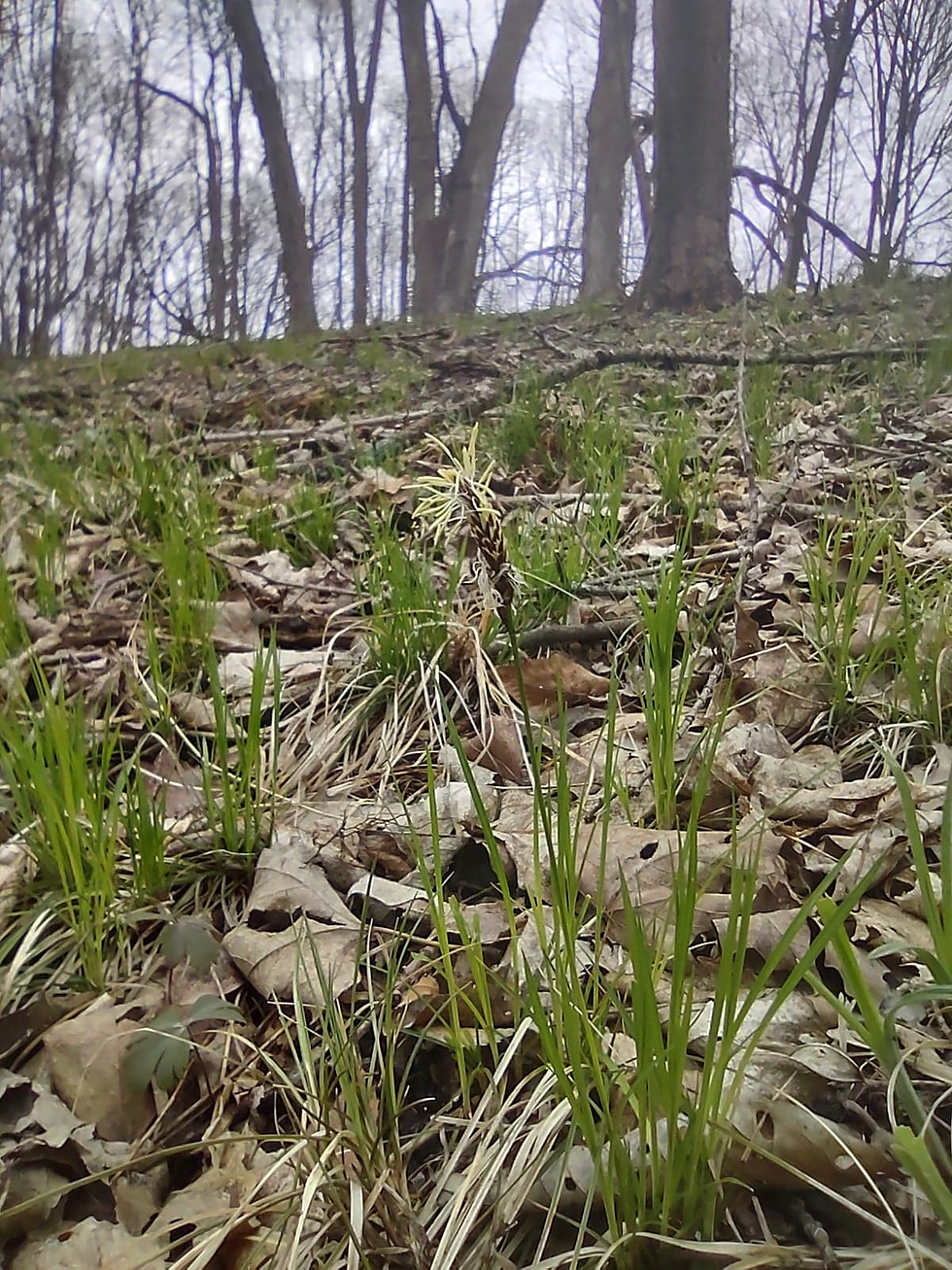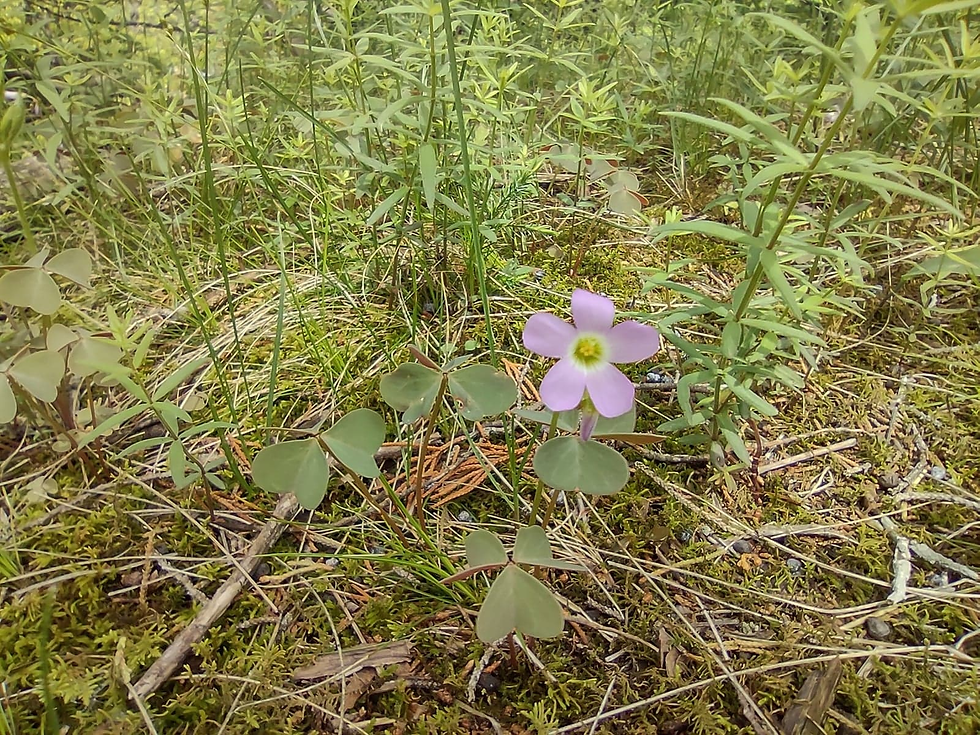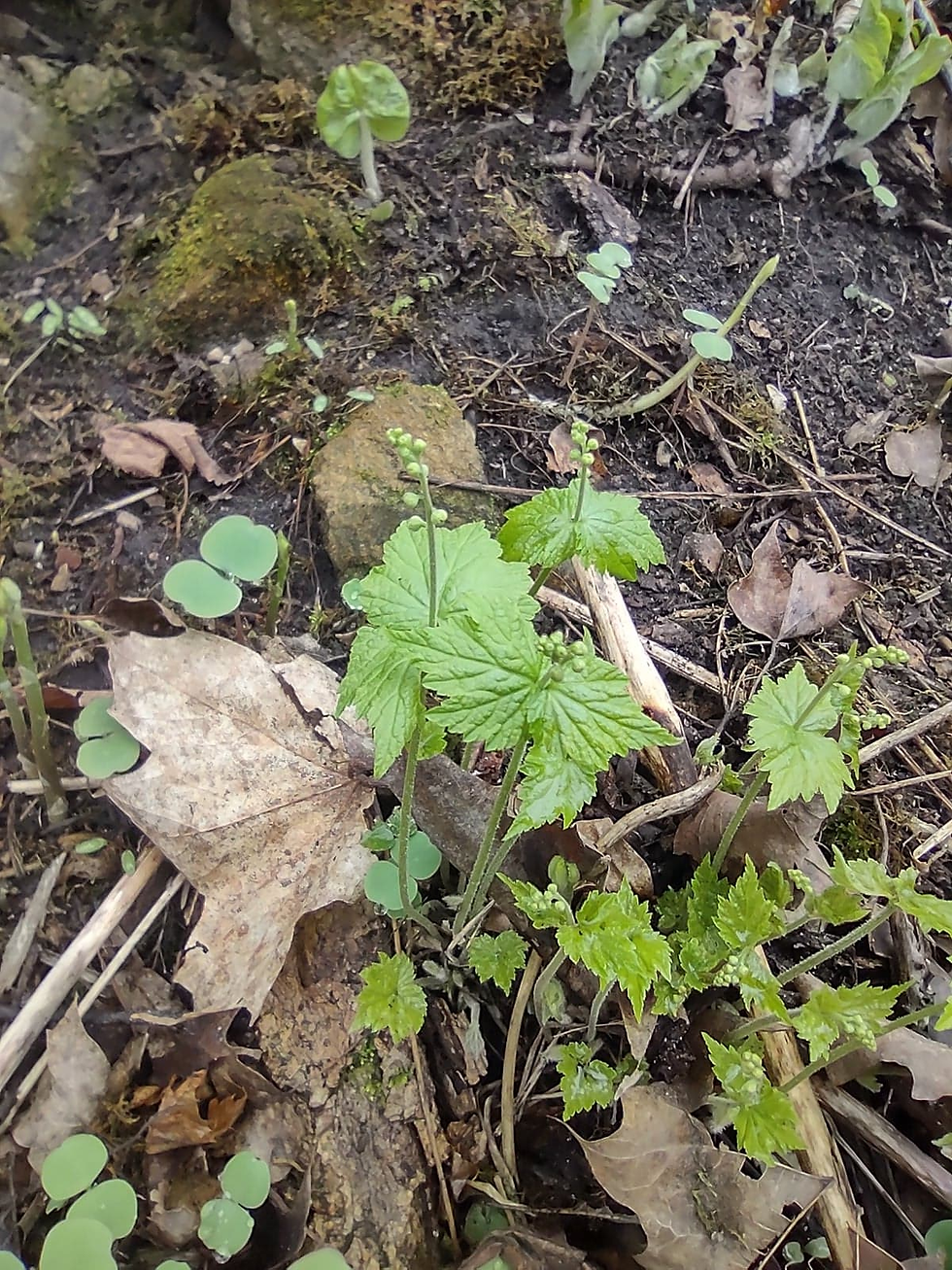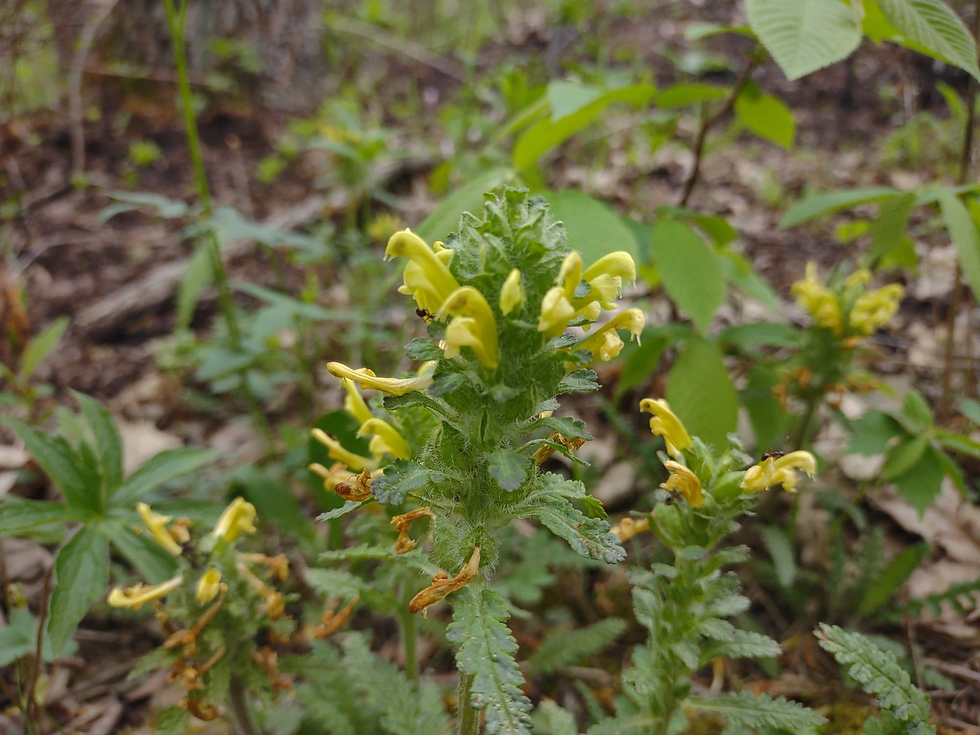April Showers Brought May Flowers
- Kenny Slocum

- Jun 6, 2022
- 8 min read
The Iowa Native Plant Society marks May as "Iowa Wildflower Month," and if you've spent any time in the woods this spring it's easy to see why. May is the month where the light conditions in the forest go from full sun to canopy cover. It is a month of copious blossoms, on everything from short-lived spring ephemerals, to sedges and early-season grasses, and even the trees themselves.
So I thought it'd be fun here in June to take a look back at 31 flowers photographed in the month of May, 2022, at Clayton County Parks.

We'll start with the icon of the early spring botanical pilgrimage, the Pasque Flower, Pulsatilla patens. One of the earliest emergences of springtime, this plant was almost done blooming by the time I caught it on a goat prairie above Motor Mill in early May.

Hepatica is an abundant and welcome sign of spring in the woods, often emerging long before the threat of frost has passed. Iowa is home to two varieties of Hepatica nobilis, the sharp-lobed (acuta, seen here from Osborne Park) and round-lobed (obtusa), the latter being considerably less common and distinguished by - you guessed it - rounder lobes on the ground-hugging evergreen leaves.

The Rue Anemone, Thalictrum thalictroides, seen here at Bloody Run, has a few look-similars in Iowa's spring woodlands. The false rue anemone, Enomion biternatum, always has just 5 petals whereas thalictroides may have anywhere from 5-12. "True" rue anemone can also be distinguished from wood anemone, Anemone quinqefolia, by having multiple flowers to a stem whereas wood anemone has but one.

Bellwort, Uvularia grandiflora, always puts on quite a show at Bloody Run and this year was no exception. These graceful flowers always look like they want to open a little more but can't quite make it, a design that makes them particularly well-suited to the buzz-pollination provided by big-bodied bumblebees who emerge alongside them in early spring.

Wild ginger, Asarum canadense, goes a step further in it's pollination ecology. The flower rests on the ground and produces an odor that attracts carrion-feeding insects like ants and beetles, who become active earlier than the more "traditional" pollinators. The fuzzy, flesh-colored flowers always remind me of a mouse doing a Corgi sploot, which must be especially attractive to the meat-hungry buggies on early season foraging expeditions.

Marsh marigold, Caltha palustris, is one of the first plants to emerge in sunny wetlands, like these beauties at Kleve Fen. Their populations dwindled greatly as wetlands were drained for agriculture, but where they persist they often do so in great abundance.

Show some love for the background players! This pennsylvania sedge, Carex pensylvanica, is one of those non-descript green thingies that fills in the herbaceous layer... most of the time. Briefly, like all sedges and grasses, they do "flower," extending their pollen-shedding organs out into the wind in the hopes of producing a new generation. It takes a close look, as seen here at Osborne, but the flowers of graminoids (grasses and grass-like plants like sedges and rushes) have the beauty to rival any showy blossom.

The violet wood sorrel, Oxalis violacea, is the oft-unseen cousin of the yellow variety (Oxalis dillenii) that pops up in lawns about this time of year. O. violacea is a much rarer plant, restricted to sites with ample sun and low-growing competitive vegetation, like this specimen had found on a limestone glade at Motor Mill.

Pussytoes, Antennaria neglecta, is a not-uncommon lawn weed, but in the restored oak savanna at Bloody Run it's got a crucial role to play. This plant actually suppresses the surrounding growth, creating patches of low-growing plants or bare spots where some of the "weaker" plants - like violet wood sorrel - can find the space to take off.

Bastard toadflax, aside from making the case for using Latin names (Comandra umbellata) especially when taking 8th graders on a field trip to the savannas at Bloody Run, serves as a reliable indicator of high-quality natural areas. These plants are hemiparasitic on a wide variety of plants, providing a similar suppressive effect to the Pussytoes that gives more varied structure to the surrounding habitat.

Jacob's ladder, Polemonium reptans, occurs in high-quality deciduous woodlands. This little fellow was under the bridge on the Osborne Nature Trail, and it's always one of my favorites. Something about the floppy growth habit, and the timing needed to catch the short bloom period, makes it feel like a real treat even if it can be locally abundant in good conditions.

This nodding trillium, Trillium cernuum, from a mixed-conifer forest at Bloody Run, has a special place in the history of modern botany. Carl Linnaeus, the inventor of binomial nomenclature, named the whole Trillium genus - all of which have a three-petaled flower above three leaves - after this species.

Shooting star, Dodecatheon meadia, was hanging on the edge of a cliff in Bloody Run just above the trillium. As human development, fire exclusion, and agriculture gradually reduced its habitat on the once-prairie ridges above, a small population has found a spot unlikely to be met with plow or cow.

Great waterleaf, Hydrophyllum appendiculatum, is a resident of high-quality, low-disturbance woodlands, and it has found those conditions in spades at the Becker East wildlife area. It's a little less common than it's cousin Virginia waterleaf (H. virginianum) and easily distinguished by the maple-like leaves and huge, gorgeous blossoms.

Mitrewort! Bishop's Cap! Mitella diphylla! This inconspicuous little fellow, potentially mistaken for garlic mustard, is recognized ecologically as the exact opposite. Scoring an 8 on the coefficient of conservatism (a 0-10 scale of how likely a plant is to occur in a disturbed area, 0 being very likely and 10 being "no one has screwed this place up yet"), its appearance at Bloody Run further testifies to the high ecological function taking place in its woodlands.

Lyre-leaved rock cress, Arabis lyrata, was following the shooting star's lead, but this time at Motor Mill. These delicate little plants were blooming in abundance along the rock faces on the south side, making due with the meager provisions provided by the act of lichens and mosses supplying nutrients on the otherwise barren rock.

Box elder trees, Acer negundo, is a tree in the maple family with two distinctly different blossoms. Above, the "male" trees extend long drooping anthers out to sway in the breeze. Below, the "female" trees have a much shorter flowering organ. Only the female flowers will bear fruit, which will develop in the fall and perhaps persist into the winter.


A brief shout-out here to the "weeds," like this common blue violet, Viola pratincola, in the lawn at Osborne. Where various city ordinances and HOA rules allowed, a lot of Iowans practiced "no-mow May" this year, a movement championed by the pro-pollinator crowd. Traditional lawns, by design, have little ecological value. But if we let them go, especially in the early season when the summer wildflowers haven't caught up, "weeds" like this one can prove invaluable to the survival of bees and butterflies.

This early buttercup, Ranunculus fascicularis, has a key identifying feature right there in the (common) name. A variety of buttercups appear in the woods throughout the year, but this one found early - May 10th - makes me pretty confident in the identification, morphological characteristics notwithstanding.

The look of awe on Orange Sweatshirt there in the background is well-placed for this white trout lily, Erythronium albidum at Osborne Park. The mottled leaves provide a show with or without blooms, which can take up to ten years to emerge from a single plant.

Botanists make their living dealing in minutae, and this woodland strawberry (Fragaria vesca) at Bloody Run speaks to that attention to detail. The more common wild strawberry would have a much shorter flower stalk, and the tooth at the leaf tip would be much longer than the teeth on either side. How's that for nitpicky? It may sound silly, but when the goal is biodiversity, knowing how to differentiate a less-common plant (this one is a 7 on the CoC scale) from its abundant counterpart makes a big difference.

Wild gooseberry, Ribes missouriense, draws a lot of ire from the bushwhacking outdoor enthusiast. The prickly stems, meant to ward off herbivory, make their thickets pretty impenetrable to all but the most dedicated mushroom hunter in springtime. But if you catch one flowering, hang out for a few minutes - you'll be shocked at the volume of bumblebees visiting each and every flower on the shrub before moving on to the next, making it an important addition to the shrub layer of Iowa woodlands.

Balsam groundsel, Packera paupercula, had a great year in the pocket prairie behind the cabin at Osborne's pioneer village. This unassuming native shows up early following a disturbance, even popping up in no-mow-May yards to indicate a successful "rewilding" effort, however short-lived.

Blue cohosh, Caulophyllum thalictroides, brings a lot of beauty to the woods all throughout the growing season. From its uniquely succulent appearance upon first emerging, to the beautifully symmetrical flowers of mid-spring, to the royal blue berries appearing in summer, this plant is a real joy to watch develop.

Hoary puccoon, Lithospermum canescens, provides one of the most reliable indications of intact ground flora of anything on this list. The name "Lithospermum" means "rock seed," a reference to the shiny, hard seed produced at the end of its short blooming season. The plant is notoriously difficult to grow from seed, meaning it doesn't tend to show up in grassland reconstructions, appearing typically only where a population had established long ago, like on this goat prairie at Bloody Run.

Alongside the puccoon at Bloody Run, abundant blooms of wood betony, Pedicularis canadensis, must have found something they liked. Like the bastard toadflax, wood betony is hemiparasitic, particularly on native grasses and asters.

Another one for the "I-think-I-have-that-in-my-yard" file, Robin's plantain (Erigeron pulchellus) appeared right next to the wood strawberry at Bloody Run. Others in the fleabane family have a weedy habit, volunteering just about anywhere the soil gets disturbed. E. pulchellus, on the other hand, scores a 9 on the CoC, indicating its relegation to only high-quality habitats. It grows taller, with a thicker, hairier stem than the daisy, trailing, or annual fleabanes.

Forming a troika with the strawberry and plantain, this golden alexander (Zizia azurea) at bloody run popped up less than a month after a prescribed burn. Shame on the wild parsnip, and the blistering rash it can give, for giving any flower with a yellow umbel a bad name. Golden alexander won't hurt you, I promise!

Remember earlier when I mentioned pussytoes' ability to stifle surrounding growth so shorter plants can get a foot (root)hold? Case in point. This yellow star grass, Hypoxis hirsuta, maxes out at about 6", giving it little chance amongst the other tall grasses and forbs of the oak savanna at bloody run, unless of course it can find some plant acting as a bouncer. *Note: this is the only photo not from 2022. This year's photograph of Hypoxis hirsuta was especially poor, even by my low standards.*

On the heels of yellow star grass - not actually a grass - we find blue-eyed grass, Sisyrinchium campestre, which is also a not-grass. Taxonomists put both plants in the lily family, despite the grass-like leaves. This photo came from the Grau Savanna at Motor Mill, a reliable spot for this conservative plant. Curiously, it also appeared this year on the sledding hill above the Osborne pond, which raised eyebrows here in the office as it's generally associated with remnant prairies and savannas. Osborne's oral history states that that whole hillside was farmed up and down, which would make this an unlikely survivor. But an examination of the historic aerial imagery showed a small patch of unplowed hillside, likely due to a seep that still traps mowers to this day. Lo and behold, the small unplowed patch lined up neatly with the site of this "new" population.

Last but not least, Yellow Lady's Slipper, Cypripedium parviflorum. The one and only flower not found in a CCCB park, but still in the county on a parcel of the Driftless Area National Wildlife Refuge. It merits special attention - and an annual pilgrimage - due to its rare status, relegated only to the highest of high-quality woodlands. A member of the orchid family, the seeds will only germinate with the right kind of fungal partnership already existing in the soil. Tack on the complicated pollination ecology just to make a seed - they have no nectar and have to "fool" a pollinator into visiting not just one flower, but two - and you have an iconic, holistic finale to Iowa Wildflower Month. While flowers make for pretty photographs - at least when it's not me behind the lens - studying them brings much more to the conservationist than a mere academic exercise. The plants above ground can speak volumes about the site's history and the other stands of nature's web to which they're hitched.




Comments